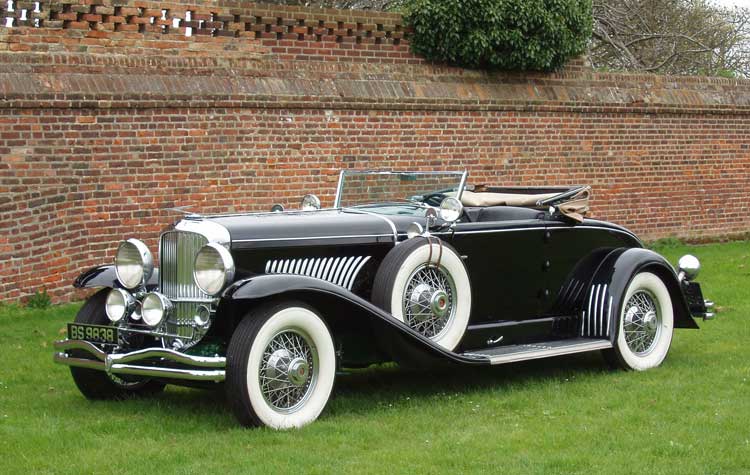Duesenberg
Mae West's motor of choice, the 'Duesy' was the ultimate status symbol in Thirties America, says Martin Buckley

Duesenberg is the aristocrat of American cars, a status-symbol collector's marque with a near- religious following.
The German-born brothers Fred and August Duesenberg came to the US as youngsters, and began their careers with a cycle shop. They had gone down the familiar route of fitting an engine to a bicycle before building, in 1905, their own car, and soon acquired a reputation for creating simple and well-engineered racing engines. They also produced marine and aircraft units for the war effort (a 55-litre V16 800bhp aero engine was one of the more heroic projects), but after the conflict, the brothers found themselves drawn to racing, and, inevitably, the Indianapolis 500. Duesenbergs won the Indy 500 in 1924, 1925 and 1927.
Current from 1929 to 1937, it was the straight-eight road machines, the J, SJ and SSJ, that made the legend, cars that married exquisite no-compromise engineering to some of the most dramatic bodywork ever seen. With a price tag of $8,500 for the chassis alone - or as much as $17,000 complete with body - the roll-call of famous and influential buyers only heightened its profile as the glamour machine of its generation. In engineering, it gave nothing away to the great European marques, and was, in many respects, in advance of them. The ultimate SSJ model was widely advertised as a 125mph car that could touch 89mph in second gear.
Ownership of a "Duesey" became almost a rite of passage for the Hollywood A-list of the Thirties - Mae West, James Cagney, Greta Garbo, Tyrone Power all owned them, alongside well-known industrialists and socialites such as J Paul Getty, William Randolph Hearst and Howard Hughes. Clark Gable and Gary Cooper commissioned special extra-short wheelbase SSJ models, which appeared to consist almost entirely of bonnet. Indeed, such was the makes reputation that Duesenberg advertisements often didn't feature a car but merely a drawing of an obviously affluent man or woman with the headline, "He/She drives a Duesenberg".
But even America's ultimate car couldn't ride out the Great Depression, and the make disappeared in 1937. Yet it carried such a reputation that it was inevitable that somebody, at some point, would stage a revival. The first of these appeared in 1959, when a Mr Kollins of Detroit built a dramatic one-off coupé body on a 1950 Packard chassis, and fitted it with a Duesenberg straight- eight engine, yielding an alleged 400bhp.
The 1966 Duesenberg seemed a more convincing attempt at a revival. The Duesenberg Corp of Indianapolis was formed with Fred "Fitz" Duesenberg as chairman of the board - Fitz was the son of August Duesenberg and nephew of Fred - and the new car was to be a super-luxurious sedan in the modern idiom rather than a retro car such as the Excalibur. Virgil Exner was hired to style the new Duesenberg, and Ghia of Italy engaged to build it, on the chassis and running gear of a 7.5-litre, 440bhp Chrysler Imperial limousine.
Having given up his job as the head of styling at Chrysler, Exner was in the middle of his "neo-classic" phase, having already proposed a "modern" Bugatti called the 101C on the last post-war Bugatti chassis of the early Fifties, left unbodied when the company closed down. It looked like a reject from Wacky Races, and sank without trace, finding no takers even among would-be Dick Dastardlys.
Exner's Duesenberg was no less outrageous, a sinister blend of contemporary American sedan and Thirties styling sensibilities in its flowing wheel arches and massive 82in bonnet, which finished in a traditional vertical radiator grille. Chromed wire wheels, shod with special oversized 17in tyres that somehow disguised the obesity of the car, were another classic touch, with disc brakes visible through the spokes. It was, claimed its makers, the longest production sedan in the world, at 20ft 4.7in, and had more headroom, legroom and wider seats (trimmed in cashmere) than any other saloon.
It was also said to have the biggest boot of any car available and, at 6,000lb, was half a ton heavier than any other American car. Twin fuel tanks gave a 32-gallon capacity, but with consumption in single figures, it probably needed them. The hedonistic spec included six-position power seats, mahogany panelling, "autopilot" (but no details as to what form this took) and "four season" climate control. Painted burgundy, and with a vinyl roof, the prototype was launched at the Indianapolis Sheraton, then toured the country clubs of Texas.
At $19,500, this Duesenberg was double the price of a new Rolls-Royce, but at its launch, the makers claimed to have 25 deposits of $5,000 from serious buyers. The first of these was Phil Wrigley, the chewing-gum tycoon, but Elvis Presley and Jerry Lewis also had their names down. Fifty were to have been produced in the first year, rising to 200 in 1967. An even longer limousine and convertible versions were planned, but the project hit trouble: the prototype was seized by US Marshals when it was revealed that Duesenberg had failed to pay its salesmen a commission.
Exner's efforts weren't wasted, however. He reprised his Duesenberg style for another glossy neo- classic called Stutz. The name recalled the skimpy Stutz Bearcat of the Twenties, but the 1969 version was a flamboyant coupé based on the Pontiac Grand Prix and much favoured by showbiz personalities. Elvis owned several, and even gave them as presents.
Given that we now have Maybach and other gilded names from the past making bids for resurrection, perhaps the time is ripe for yet another Duesenberg revival.
Subscribe to Independent Premium to bookmark this article
Want to bookmark your favourite articles and stories to read or reference later? Start your Independent Premium subscription today.

Join our commenting forum
Join thought-provoking conversations, follow other Independent readers and see their replies